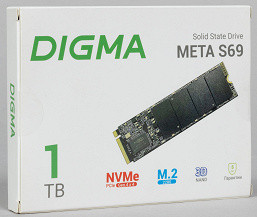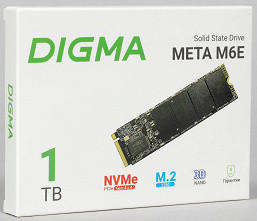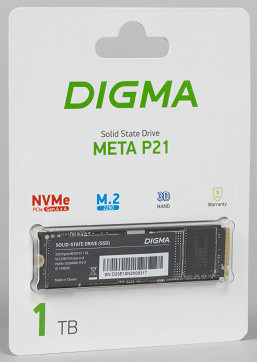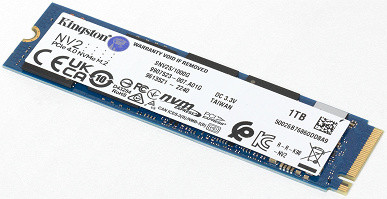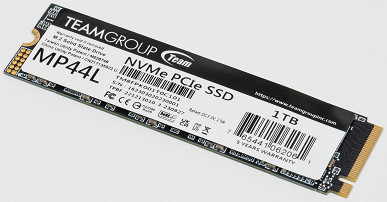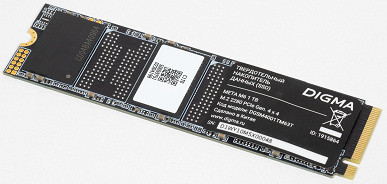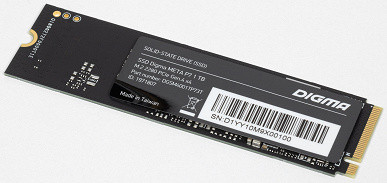Five years ago, the first mainstream PCIe Gen4 SSDs appeared, but they lacked much variability. All models were based on the Phison E16 controller with SK Hynix DDR4L-2400 DRAM (1 GB per 1 TB) and 96-layer BiCS4 TLC memory from Kioxia. However, these drives did not demonstrate significant improvement over Gen3, which caused criticism. The main reason was that memory manufacturers had not yet mastered the fast internal interfaces required to fully unleash the potential of Gen4. Despite high peak sequential data transfer rates, such drives did not provide a tangible advantage in real-world applications. This was due to the fact that at the time of PCIe Gen4’s appearance, existing memory solutions did not require high bandwidth, since Gen3 and SATA imposed stricter limitations. As a result, eight-channel controllers fully utilized the capabilities of Gen3, and budget four-channel solutions delivered their 2 GB/s, which was considered sufficient.
Over time, memory manufacturers solved the problem, and SSDs began to better utilize the capabilities of PCIe Gen4. However, before consumers had time to master Gen4, SSDs with PCIe Gen5 support began to enter the market. Flash memory speeds grew, and even four-channel controllers began to approach the limits of Gen4. These achievements occurred gradually, over several generations of controllers.
Currently, there are several generations of four-channel controllers for Gen4 on the market. The first models are no longer relevant, but the “penultimate” ones are often of interest, especially given their price. SSDs with a maximum speed of 7 GB/s will cost more than 5 GB/s drives, since the former require more expensive memory.
Another important point concerns modern memory crystals. Old models often used 512-gigabit crystals, but now they have been replaced by terabit ones. For high-capacity SSDs, this isn't as noticeable, but for 512GB or 1TB drives, it does matter: newer models have a lower degree of interleaving, which can negatively impact performance.
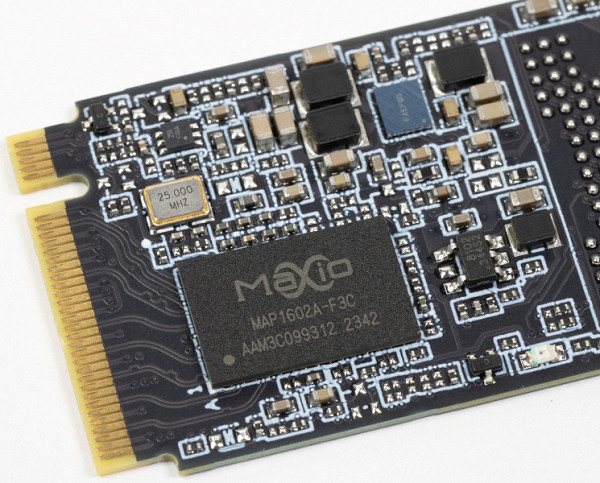
The controllers in the drives may be the same. An example of this is Maxio MAP1602. When paired with 232-layer TLC memory from YMTC, these are “seven-gigabyte” models, and with 128-layer YMTC or 176-layer SK Hynix, they are “five-gigabyte”. However, there is a geopolitical nuance: sanctions have been imposed against YMTC that affect 232-layer memory, and it cannot be sold in some markets. Therefore, some manufacturers use a flexible approach. For example, Adata Legend 900 is available in two versions: one with MAP1602 and 232L YMTC for the Chinese market, the other with Phison E27T and 162-layer BiCS6 Kioxia for other regions. As a result, the former are more common in our market, and the latter in the USA, which is due to American sanctions. The range of «five gigabyte» models is wider, since 128-layer YMTC memory is not subject to sanctions, and memory from SK Hynix does not cause any complaints at all. In this segment, Phison and Silicon Motion have different controllers, but «faster» solutions appeared later and are less common. Theoretically, «fast» SSDs on InnoGrit IG5220 are possible, but in practice they are not. But the TenaFe TC2200 controller is actually used for models with 5 GB / s, which expands the choice. An example is Kingston NV2, which can work on TC2200, although Phison or Silicon Motion controllers are more common there.
Thus, the choice of models with 5 GB / s is much wider, which has a positive effect on prices, which in this segment are already lower than those of faster SSDs. At the same time, although the controllers may be the same, sequential speeds do not always decide everything. Differences in memory and controllers can impact performance, but not always enough to justify the price difference. This is especially true for older computers without PCIe Gen4 support, where buying an older model can be worth it, although those SSDs may be noticeably slower.
Until recently, there were gaps in our knowledge in this segment, since it is impossible to test absolutely everything — you have to set priorities. However, today's tests will help to close many of these gaps. We are looking at three different platforms with the same positioning at once, and from one manufacturer. And the manufacturer should be praised for this — the uncertainty of budget SSD configurations is already starting to get tiresome. Two examples: Adata at least separates Legend 900 versions by market, and their characteristics are not very different. But Kingston NV2 has been a «hodgepodge» from the very beginning: two controllers at the start (now there are four), with both TLC and QLC memory. One name, you can't understand anything by the price — how to choose here?
That's why we like manufacturers that go against such trends. For example, Digma — here the controller is clearly indicated in the model name. The memory may change, but all SSDs of this brand so far use TLC, which is indicated in the specifications. Of course, the choice can be complicated when the buyer has four very similar models with the same price, but at least there is an opportunity to make an informed choice, and not hope for luck. Whether to look for differences in such cases is an interesting question, which we will also try to consider.
Digma Meta M6E 1 TB
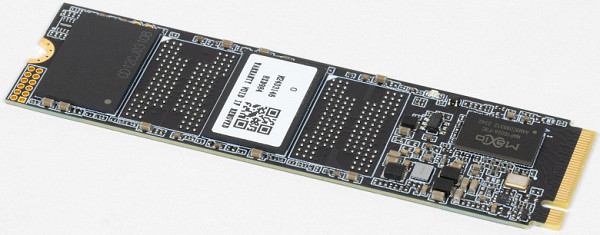
We have already mentioned this model during testing of its older version, which appeared a little earlier. The company chose an interesting strategy of priorities: in the fall, the Meta G2 based on the InnoGrit IG5220 controller was already presented in the «five gigabyte» segment. The main attention was then focused on the rapid launch of the «seven gigabyte» Meta M6 and P7 models. Only after that did they start expanding the range in the middle segment.
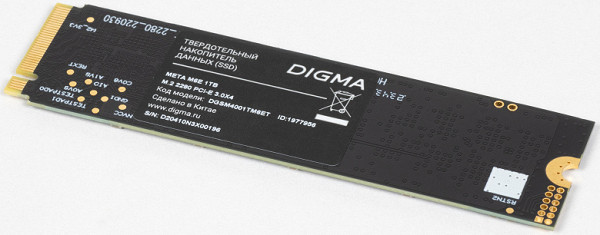
At the same time, we had to be a little creative in choosing the model name. Usually, the company has long used the approach in which a specific controller is embedded in the name — according to the «letter — number» scheme, where the first letter denotes the manufacturer, and the number is usually the last or penultimate digit of the controller model.
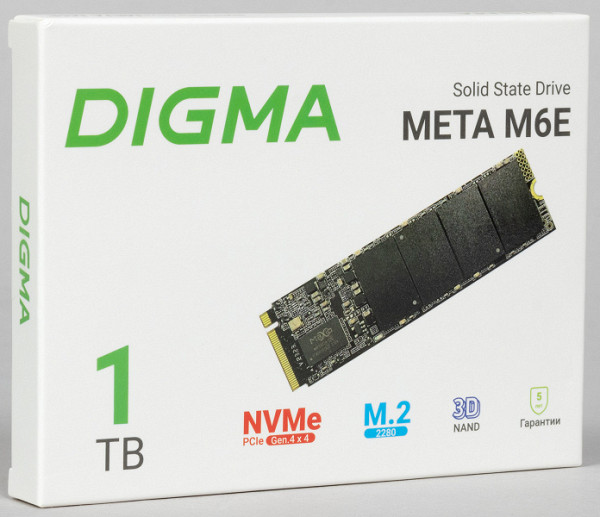
The MAP1602 controller is present in both series, so we had to use the same naming scheme as HikVision — with the G4000 models and the budget version G4000E. Looking ahead, we can say that the old naming scheme caused some difficulties with all three models tested today.
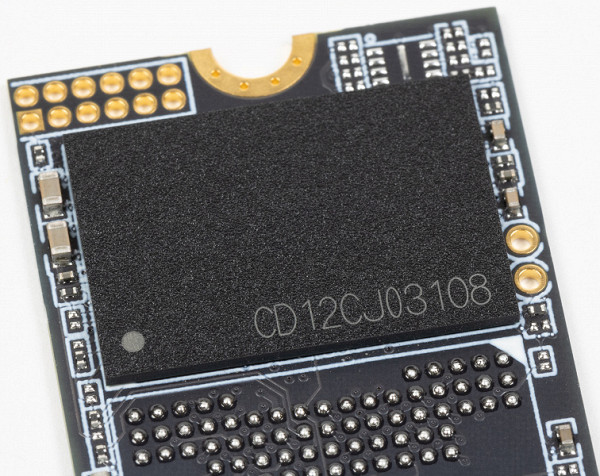
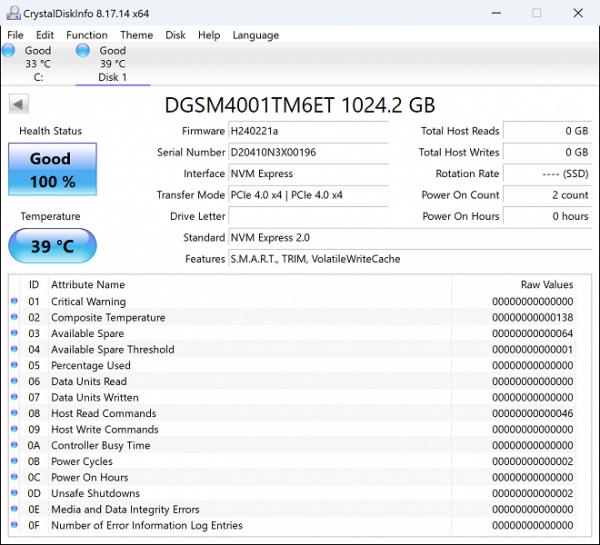
In general, if we take the issue seriously, it is worth comparing the new version of the Maxio MAP1602 platform with at least two already studied ones — using 128-layer and 232-layer YMTC memory. However, it is worth considering other options.
Digma Meta P21 1 TB
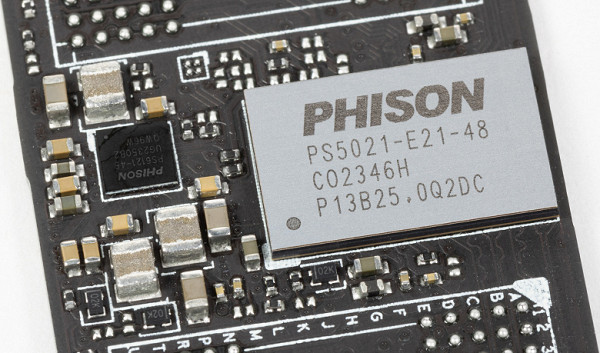
The Phison E21T controller has been on the market for quite some time, but there are still many aspects to study. For example, we encountered it on the example of Kingston NV2, where the platform did not show its best. This is due to the fact that under one name you can find drives with different characteristics. In the initial line, there were models on Silicon Motion SM2267XT with PCIe Gen4 support and QLC memory, where the specifications were set as universally as possible, which led to the slowdown of the fastest versions — probably so that their users would not be overly happy. Nevertheless, even the slowed down P21T with TLC memory looks more interesting than SM2267XT with QLC, which is still a positive moment and indicates that a lot of attention is paid to the controller.
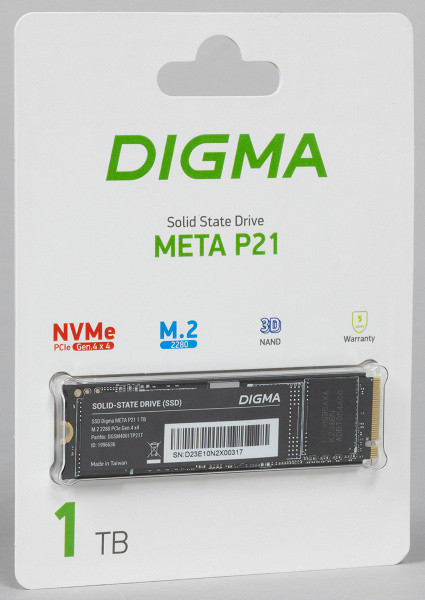
We have long wanted to test this platform in a more canonical version.
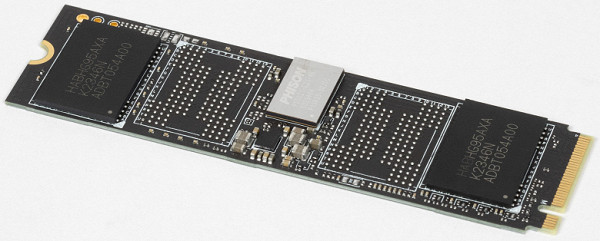
And this will happen today, thanks to Digma, whose range of products includes such SSDs relatively recently.
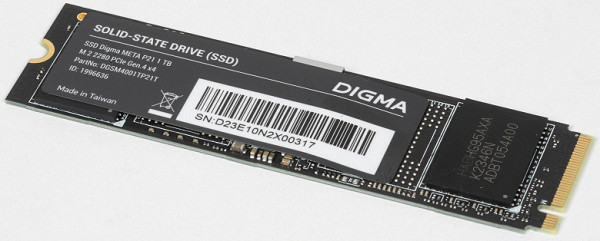
The names also had to be improvised: the most logical would be to use a name that coincides with the earlier Run P1 models. Although this is a different family, to avoid confusion, the indexes were made unambiguous, as was done.
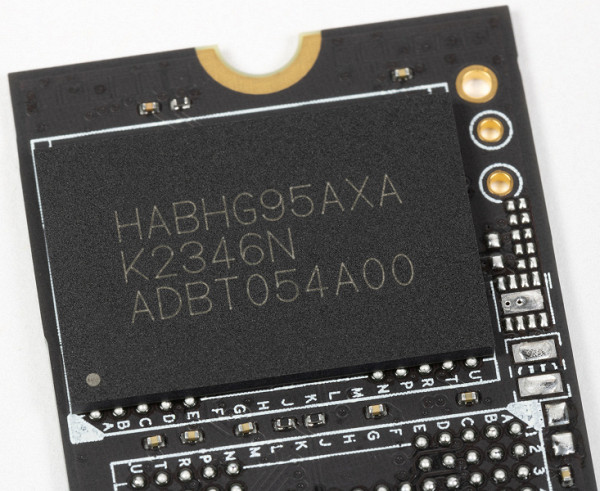
Comparing the P21 and M6E is a good idea because both models use nearly identical memory — SK Hynix 176-layer TLC flash. The main difference is that the P21 uses 512Gb dies, while the M6E uses paired devices of two such dies. This is not due to any particular purpose (pairing dies is usually reserved for high-capacity models); it is likely that such dies are simply cheaper.
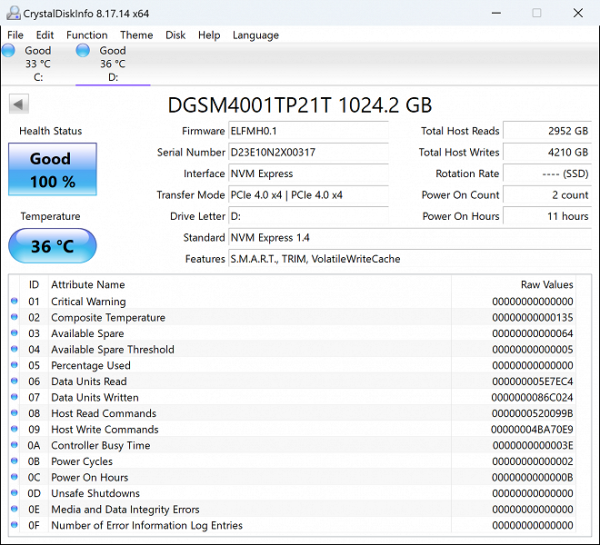
In other batches the situation may be different — we repeat, but the specific memory is not specified in the specifications (unlike Digma Pro, where everything is always clearly specified). It is important that at the moment we have almost identical models, and not just models of the same class.
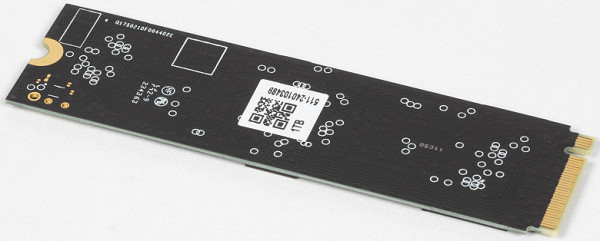
Digma Meta S69 1 TB
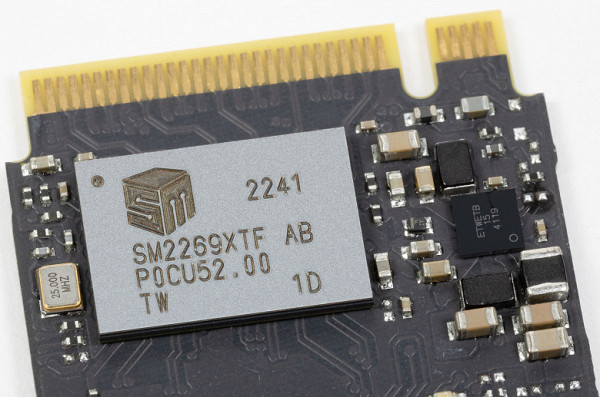
The Silicon Motion SM2269XT controller is the successor to the SM2267XT and a direct competitor to the Phison E21T, as well as the Maxio MAP1602 in its «slow» versions. To compete with faster models, the Phison E27T and Silicon Motion SM2268XT are required. We reviewed the first of them last year using the Digma Meta P7 as an example, and the second appeared much later — but we will definitely return to it. It is not yet entirely clear why Silicon Motion chose such a strange marking scheme for its controllers, first jumping two units forward and then taking a step back.
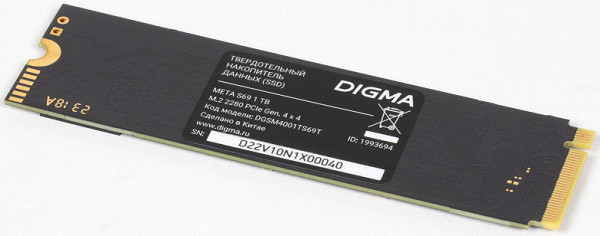
The SSD name is similar to the Meta P21 — it was possible to keep one digit, but then the model could be confused with the budget Run S9. It will be interesting to see how Digma approaches the name of a hypothetical SSD based on the Silicon Motion SM2268XT controller. We are sure that this will happen. For now, the S8 index is free, but there is a feeling that a return to two-character model numbers is no longer in sight.
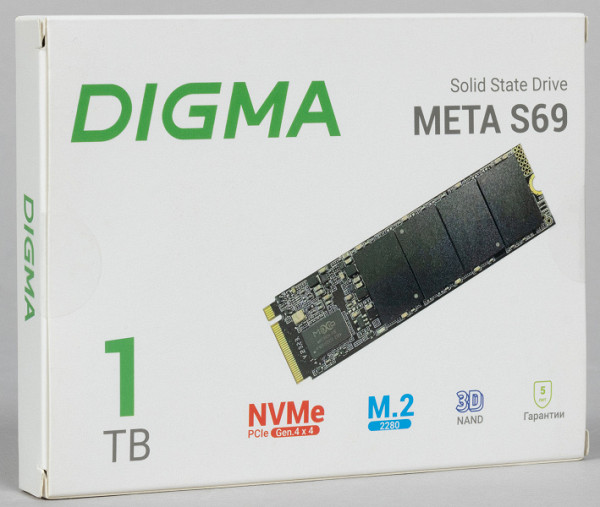
The packaging looks funny — the designers seem to have decided to save time and use the same box as for the Mega M2, just changing the inscriptions. This also applies to the Meta M6E, but there it does not cause cognitive dissonance, since the package shows an SSD with a Maxiotek controller, and this is quite acceptable. In this case, the image on the package does not match the contents, which causes some confusion.
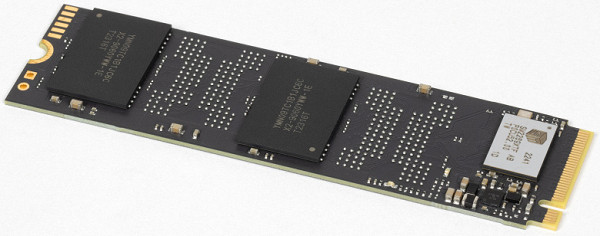
These questions are mainly important for raising general awareness. In practice, the benefit of them is that the names of Digma SSDs are unambiguous and convenient. This only applies to the controllers — the memory can change, although TLC remains, and this is also indicated in the specifications.
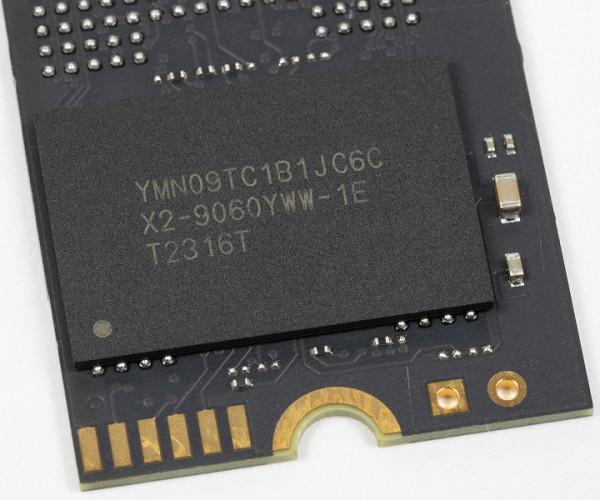
In a specific Meta S69 sample, we found the very same 128-layer YMTC memory that we expected to see in the Meta M6E. However, “our” M6E was released in March, P21 in February, and S69 in January. The situation in the next batches may change — we have already emphasized this more than once and will continue to emphasize it. You should not expect complete certainty, especially in this segment. On the other hand, different variations of the same type of memory do not introduce fundamental changes, and with significant differences in the base, different models appear — as can be seen in the example of M6 and M6E.
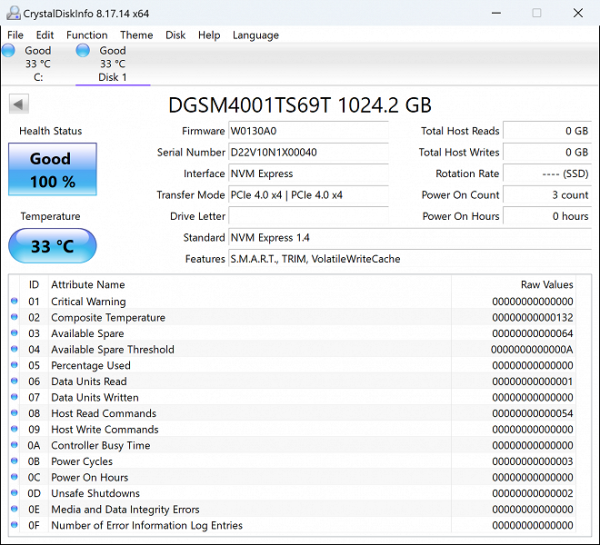
In addition, the performance of any platform may change over time due to firmware optimization. Usually, the changes are minor, and you should not expect breakthrough improvements, although in the top segment, serious errors identified in the race with competitors can be fixed, sometimes with the addition of new problems. Budget platforms are more stable in this regard, since their development is less hasty and many users do not track firmware updates or do not install specialized software.
Nevertheless, minor changes in the firmware do happen, and they should be taken into account. However, in most cases, firmware updates are related to adaptation to new memory, and not global improvements. When analyzing tests, it is important to consider the date of their publication and the conditions under which they were conducted, but keep in mind that it can be difficult to buy an exact model with the same characteristics in a store, especially in the budget segment.
Now we will move on to the tests and their results obtained on the current versions of all three models. As already noted, the situation may change slightly in future games, but overall this should not significantly affect the results.
Testing
Testing methodology
We use a test bench based on the Intel Core i9-11900K processor and the Asus ROG Maximus XIII Hero motherboard with the Intel Z590 chipset, which allows you to connect the SSD in two ways — via the «processor» PCIe Gen4 lines and via the «chipset» PCIe Gen3 lines. Modern SSDs are designed to work on PCIe Gen4, which allows them to reveal their full potential. However, the compatibility mode on PCIe Gen3 also has its significance, since this controller was introduced in the Intel «hundredth» series chips (2015) and has not changed fundamentally. Today, we decided to use only the «native» PCIe Gen4 mode to save space, since the issues of the influence of interface limitations have already been discussed in detail. All tested SSDs will be compared in PCIe Gen4 conditions, avoiding direct comparison with similar Gen3 models, since identifying differences in such conditions may not be very productive.
Samples for comparison
We definitely need a Kingston NV2 to understand how much Kingston is not telling buyers. It is obvious that PCIe Gen4 support in this model does not bring any tangible benefit, although the Phison E21T controller is not limited in this regard. For maximum testing accuracy, we also use TeamGroup MP44L, a classic “slow” Gen4 Maxio platform with 128-layer YMTC memory. Recall that similar memory is used in the Meta S69, which will ensure that the controllers are compared under the same conditions. In addition, the Meta P21 and M6E use the same memory, which makes the five models tested almost self-sufficient.
To complete the testing, we added two higher-end Digma Meta SSDs, the M6 and P7, which we reviewed last year. They are a bit more expensive, but as mentioned earlier, the new terabyte models may lag behind the older ones due to the peculiarities of the memory of different generations. This is especially true for the P21 and P7 pair, since the BiCS6 memory itself is not the fastest.
Thus, we have almost completed the review of inexpensive SSDs on quad-channel controllers and TLC memory with a capacity of about a terabyte. The only unstudied controller remains the Silicon Motion SM2268XT, but we plan to review it in the near future.
Filling in data
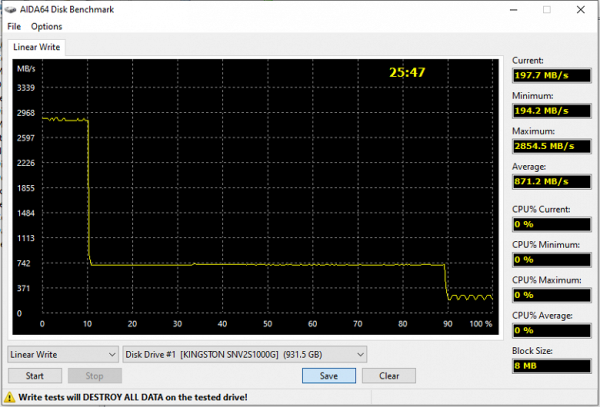
The top image shows the Kingston NV2, the bottom one shows the Digma Meta P21. Comments are probably unnecessary here. The example of the second drive shows that the Phison E21T controller does support PCIe Gen4, although the direct write speed to TLC memory is different. Despite the apparent similarity of the platforms, the SSDs are quite different.
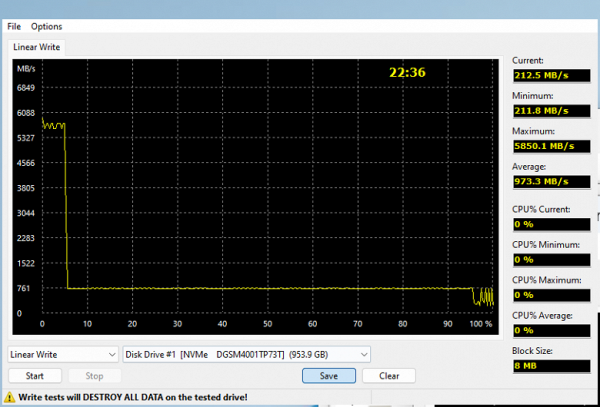
The Meta P7 clearly demonstrates the nuances of the new memory. Although the write speed to the SLC cache of the updated platform has increased, the cache itself remains small, and direct write has noticeably worsened due to the limitations of interleaving and other features. Therefore, if you need a terabyte SSD with a Phison controller, it is better to choose the Digma P21, especially if the write speed is important. We will consider other scenarios later.
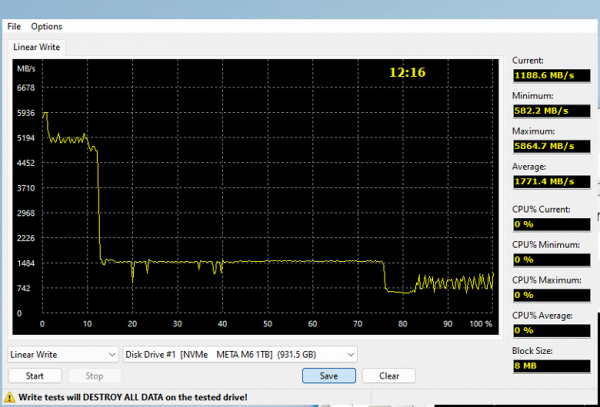
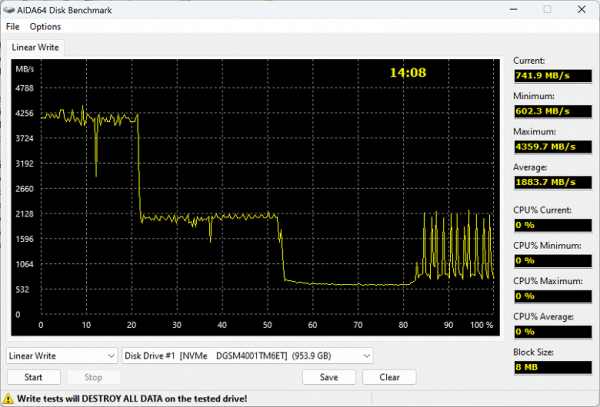
Now let's look at the Maxiotek-based pair, and here the choice becomes more difficult. Both models have the same controller, but the new YMTC memory has increased internal parallelism. In addition, the M6E has a slightly larger SLC cache, which also affects performance. As a result, although the M6E (bottom) is slightly inferior to the M6 (top) in overall test execution time, it shows better results in direct writes. The performance ratio is similar to the «Physics» pair.
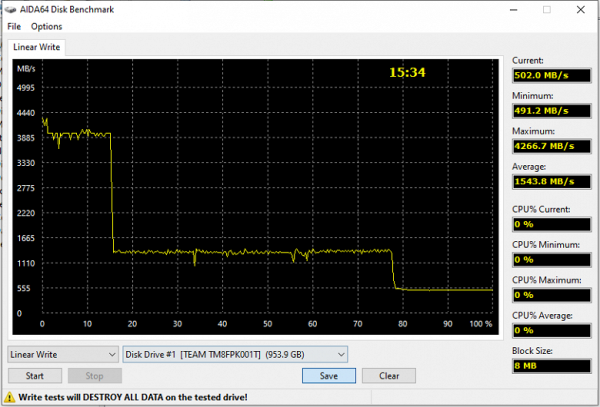
Although this is largely due to the memory upgrade — initially, 128-layer YMTC memory was mostly encountered, and it is not capable of records such as 2 GB/s, paired with a four-channel controller.
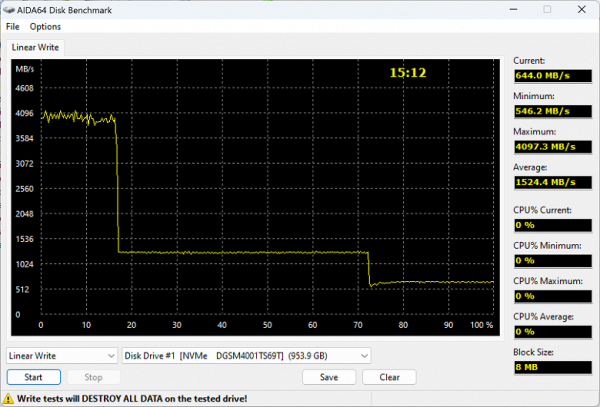
Perhaps the memory features spoil the results of the SM2269XT in Meta S69 a little, as the graph is almost identical to Team. Although the controllers are different, the memory and firmware are similar, which explains the result. Perhaps the situation will improve over time, as happened with the Maxio platform in the middle class.
Here we have two groups: the clear outsider is the Kingston NV2, which is clearly slowed down, and the Meta P7, which showed a result of more than 22 minutes, which was unexpected. The other models are grouped quite tightly, and the Meta M6, although not a clear leader, still shows better results compared to the P7. So far, the extra charge for the senior models is not justified, as expected. Perhaps more complex testing scenarios will change the picture.
Maximum speed characteristics
Low-level benchmarks, including CrystalDiskMark 8.0.1, have long been victims of the SLC caching crusade, as they mostly test cache speeds. However, the information provided by manufacturers about device performance is also limited by caching, so checking this data remains useful. After all, the main goal of caching work is to ensure high speeds in real-world use cases, despite the falling cost of memory.
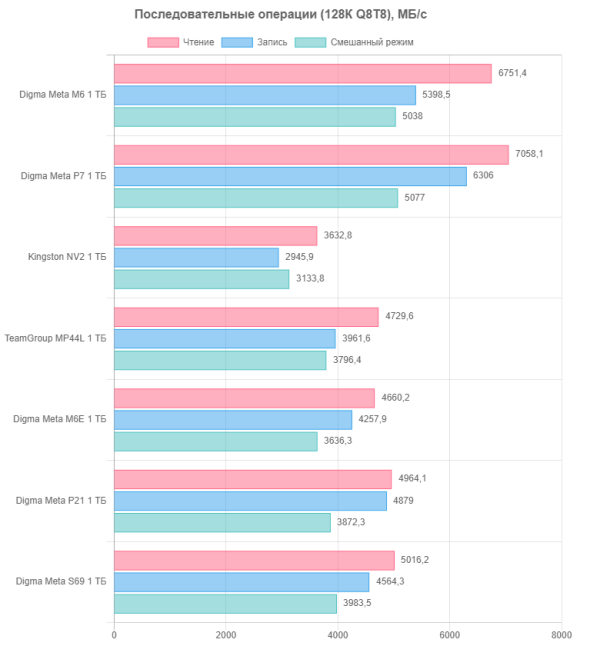
Since we are testing only cache, the results should not be surprising — this test is designed to hide the shortcomings of the memory. We see three main groups of results — as expected. The two latest-generation SSD models are in the lead, while the Kingston NV2 lags behind everyone else, as it was adapted to the performance of the previous generation. The remaining four SSDs, supporting speeds of up to 5 GB / s, i.e. PCIe Gen4, but not «full-fledged», show varied results. The Meta P21 stands out in particular, showing almost the same 5 GB / s when writing, which is rare in this class. We were lucky with the current configuration — the results are decent.
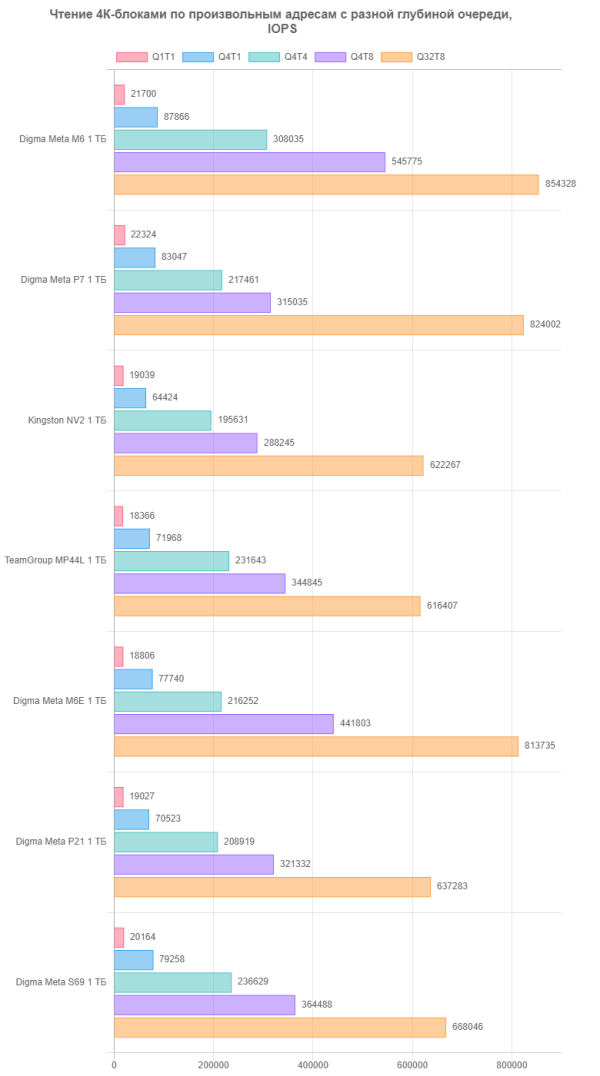
Although this is pure high-performance sports, developers cannot abandon this approach, despite similar results. Peak performance tends to a million operations per second, and in the most complex scenarios sometimes exceeds 20 thousand operations. Ironically, this is the only test that is more or less close to reality, although in practice, tens of times less is often required. Such a power reserve, of course, does not hurt, but most likely no one uses it. Hard drives lost in these competitions because their results were an order of magnitude lower than the required level. While SSDs demonstrate results 200 or more times faster, although such speed is not required in practice.
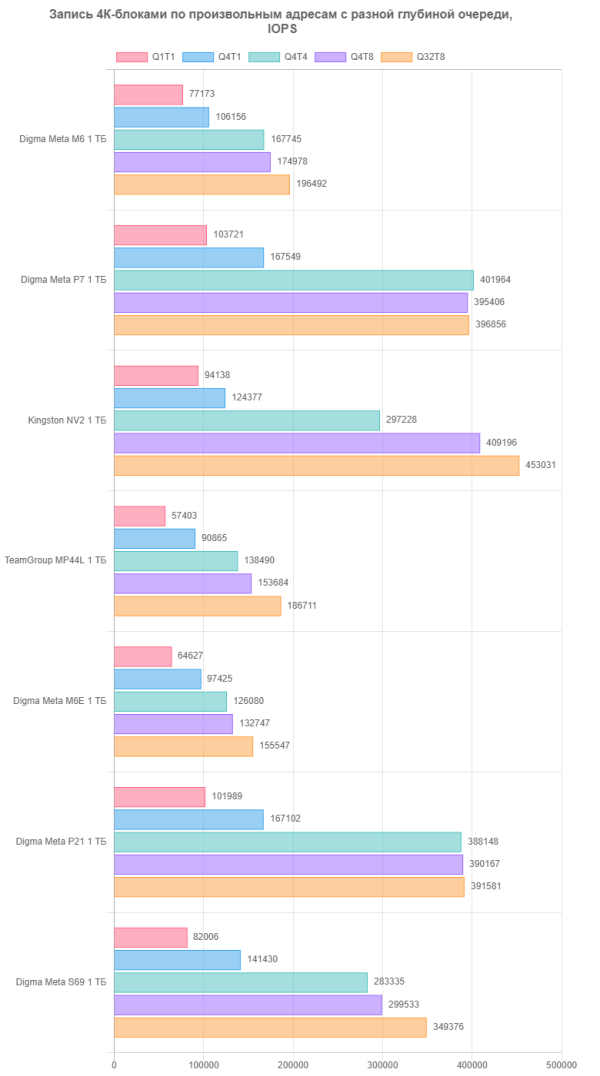
When writing, the results show a larger spread, which would be interesting if it had practical significance. The logic of dynamic address translation and SLC caching together provide tens of thousands of operations per second even in the most adverse conditions. If the numbers are interesting for the sake of numbers, then the main conclusion is this: the results are influenced by all elements — the controller, the type of memory, its size, and even the central processor, which must efficiently generate requests. But if you lower all this to the practical plane, then the dividing line becomes quite simple: SSD or not.
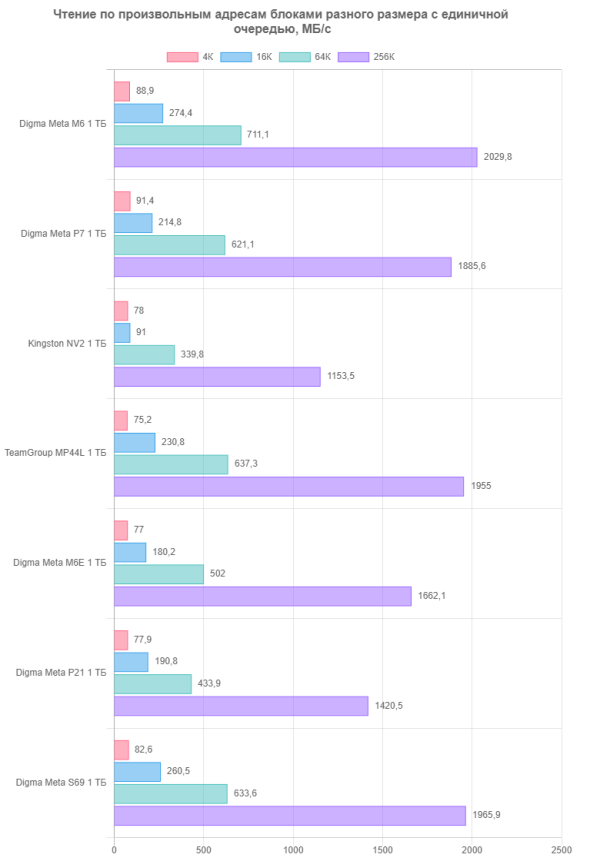
In practice, long queues do not occur, since the speed of processing requests by the system, even in the most unfavorable conditions, usually exceeds the speed of their receipt (in real scenarios, not in benchmarks). Large data blocks do exist — the number of operations with them decreases, but the processing speed increases, which has served as the basis for optimization since the days of hard drives. Modern SSDs, even budget ones, already exceed the capabilities of old interfaces such as SATA. All that remains is to teach the software to effectively use these new technologies.
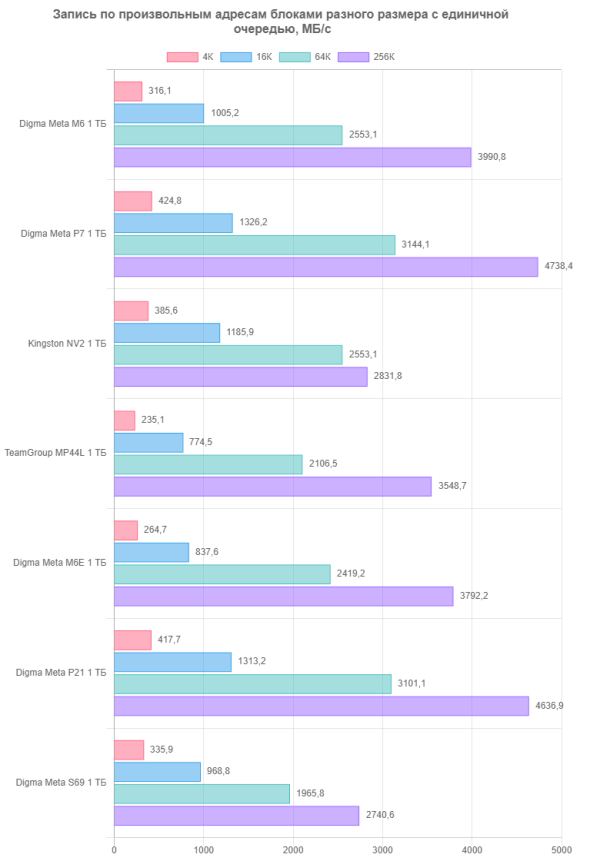
Writing to SSDs has long been optimized and parallelized by controllers, which allows you to reach gigabytes per second even in simple benchmarks. However, paradoxically, all this speed is reminiscent of the joke about Cinderella turning into a pumpkin — the performance of drives has long been insufficient for complex software requests. Moving away from mechanical hard drives solved this problem. Now users are waiting for programmers to be able to use all the new features. And SSD controller developers continue their race for performance simply because they can.
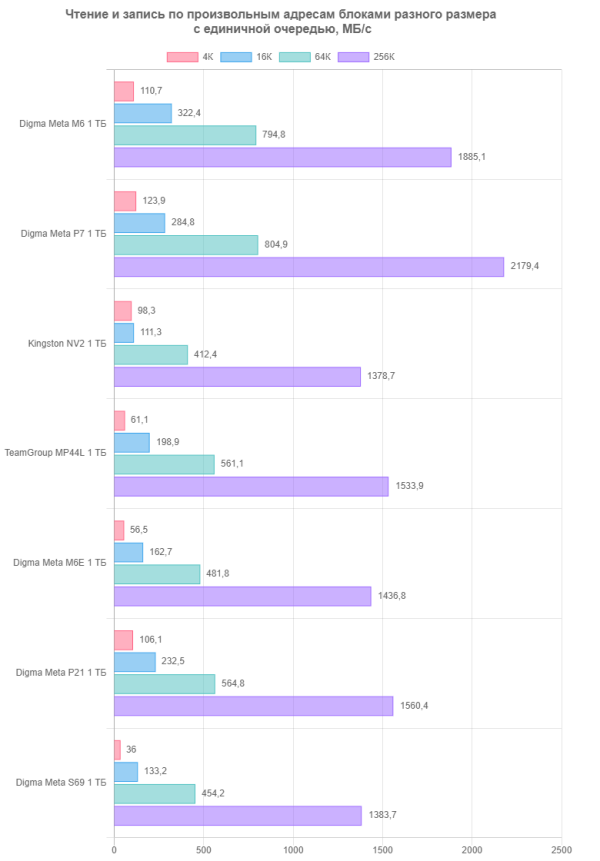
Mixed mode of operations also plays an important role, because in real life, unlike in tests, there is rarely a situation when data is only written or only read. This is especially true in multitasking systems with their complex internal structure. But in tests, we are unlikely to see anything interesting until we go beyond the SLC cache. It is easy to optimize the operation of controllers within the SLC cache, and developers do this. In practice, data may have less locality and will not always be freshly written, which distinguishes real scenarios from idealized benchmarks. The latter serve as a kind of standard on which we rely for global conclusions, although in practice the results may vary.
Working with large files
While the numbers in low-level utilities may be impressive, achieving such speeds in practice is not always possible. This is because tests like CrystalDiskMark work with relatively small amounts of information within a single file. In real-world conditions, the file will most likely only be in the SLC cache during the test, and you will have to take into account additional file system operations such as MFT modification and journals, which slow down the write process. Real-world writing involves working with different data blocks and partially small blocks. For a more accurate analysis of practical performance, it is better to use tools like the Intel NAS Performance Toolkit. They allow you to test not only the cache, but also the device’s operation in more realistic conditions, when there is almost no free space, which is what we do.
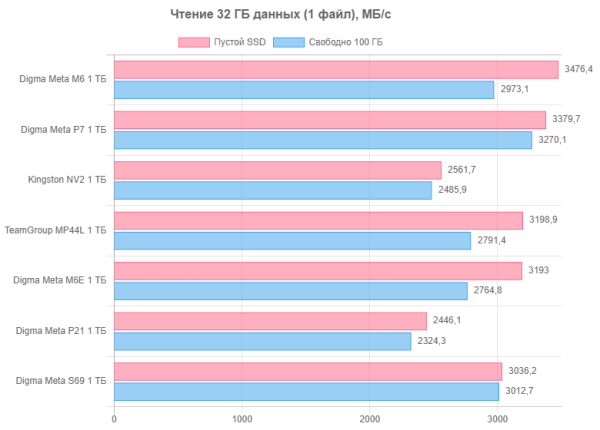
Single-thread operation is the most frequent (146% of cases) and at the same time the most difficult scenario. However, even in such conditions we already exceed two or even three gigabytes per second, although for many SATA is still enough. An interesting point: Digma Meta P21 and Kingston NV2 show almost identical results in this mode. This means that Kingston has limited its speed indicators not globally, but only in peak situations. If this is confirmed, it will be great news.
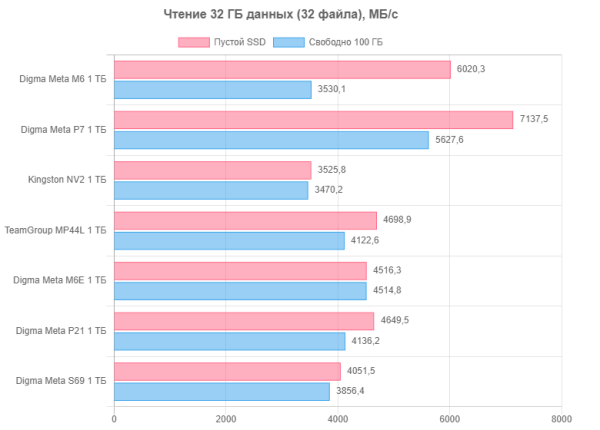
Unfortunately, multi-threading is still more of a theoretical concept than a practical reality — otherwise life would be much faster :) Key points: many (especially inexpensive) SSDs still have trouble maintaining high read rates when switching from cache to the main data array. Files evicted from the cache can be read 1.5 GB/s (Meta P7) or even 2.5 GB/s (Meta M6) slower than those just written. Thus, the promised 6-7 GB/s have limited practical value, even if they are confirmed by low-level benchmarks. For real-world performance, it is important to increase capacity and interleave ratio. If this is not required or the budget is limited, older models may be faster, as their speed losses are less noticeable.
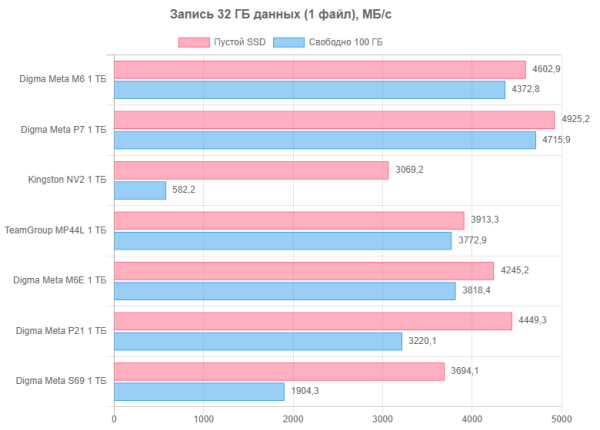
SSD write speed largely depends on how much data gets into the cache and the penalties associated with it, as well as on the operation of the operating system's file processing functions. Even inexpensive SSDs can experience limitations due to OS features, but most often the problems are related to the internal limitations of the device itself. As before, «slow» memory can only be improved by increasing the cache, which can make the situation worse if there is not enough of it. With fast memory, it is better to avoid such cache problems. The difference between SSD generations is noticeable in tests, but in practice it is not always so obvious.
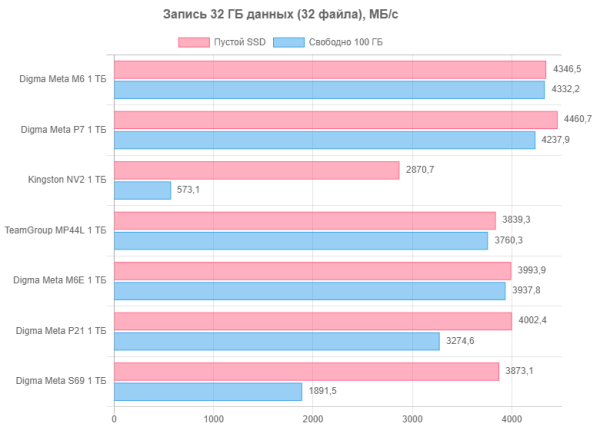
For hard drives, these two scenarios are fundamentally different, but for SSDs, they come down to a common denominator. The difference exists, especially for budget controllers, where the work remains a little more complex. However, this does not make any fundamental changes to the conclusions.
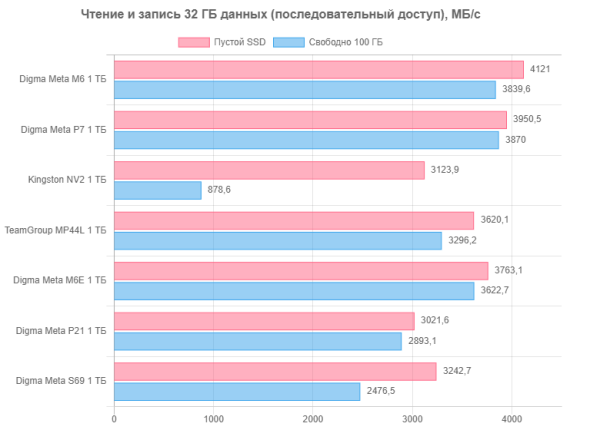
Multi-directional work is more complex than multi-threading in one direction, but it does not fundamentally change the overall picture. In this class, we reach several gigabytes per second when everything works as intended, and we encounter problems when caching cannot hide memory shortcomings. This is most noticeable in the Kingston NV2, which tries to imitate previous generations of SSDs and does not use its capabilities to the fullest.
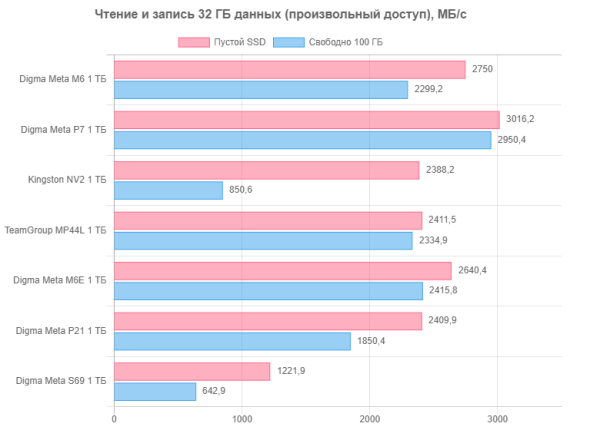
Unexpectedly, the Meta S69 turned out to be an outsider, the results of which are more reminiscent of older models based on Silicon Motion SM2263XT. In practice, this will most likely not be noticeable, except for direct comparison with other devices. The reason for this result is still unknown, but it is possible that the firmware still requires revision, and this will be corrected in the future.
Comprehensive performance
PCMark 10 Storage is currently the best comprehensive benchmark for testing storage devices, as we already mentioned in our review. Of the three tests included in the suite, the most useful is the Full System Drive test, which covers almost all common scenarios, from booting the operating system to regular data copying. The other two tests are just subsets of this main scenario and are not so interesting.
The full test is useful not only for accurately measuring real throughput, but also for assessing the delays that occur when performing practical tasks. Although averaging these metrics and bringing them to a single number may seem somewhat synthetic, this is still a closer estimate to reality than individual tests. Therefore, it makes sense to familiarize yourself with this benchmark.
The total write volume of all subtests is 200 GB, which guarantees an excess of cache with only 100 GB of free space. There is no way to quickly free up space due to the lack of pauses. Although PCMark 10 Storage's workloads reflect real-world scenarios, they represent a pessimistic view of how storage devices will perform. Real-world workloads can extend over much longer periods of time, which can reduce the number of issues. However, it's best to take this pessimistic approach when planning for the future to avoid unpleasant surprises.
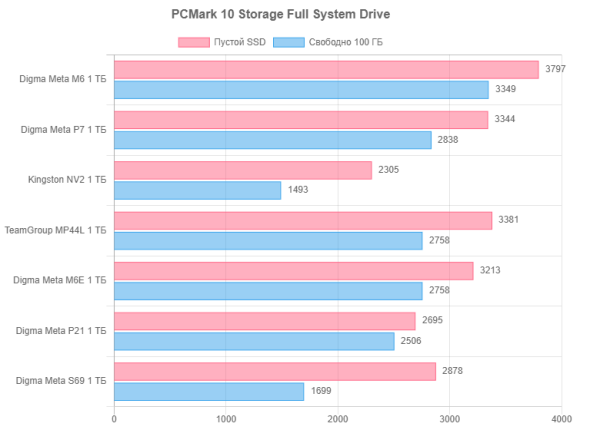
It is interesting to note the “super-stable” results of the Meta P21, which is explained by its small cache and fast memory, which are supposed to behave that way. It is also noteworthy that the “slow” versions of the Maxio MAP1602 show results close to the “fast” Phison in both tests. Factors such as the low capacity of the Phison (which would have been laughable to call small five years ago) play a role, but the Meta M6 copes with this problem at the same price level.
It is important to remember that the differences in benchmarks are not always noticeable in real life. PCMark 10 Storage simulates real-world scenarios, but the intensity of the workloads in it is artificially inflated. There is also the problem of the discrepancy between accurate measurements and user perception — some operations that seem instantaneous or very fast may not noticeably increase the numerical results. For example, Optane SSDs were once unrivaled in terms of the totality of characteristics, but many users did not appreciate this, since the difference between a program starting in five or six seconds was insignificant.
Serious slowdowns in some tasks (even simple ones, like copying large files) are always noticeable and annoying. In this class of SSDs, such problems are rare, unlike cheaper models, where they can appear depending on usage scenarios. Today's trio of tested SSDs represent a reasonable compromise between expensive top models with excellent characteristics and cheap ones, where not everything is always good. The numbers may vary and change from batch to batch.
Total
The main advantages and disadvantages of SSDs of this class have already been described in the review, and today's Digma Meta trio illustrates these characteristics well. Although the configuration of these SSDs is somewhat predictable (the controller is known, but the specific memory is not), it is worth remembering that even TLC memory can be different. Memory interacts with the controller differently, which is aggravated by firmware changes during the life of the drive. We should not forget about the price. For example, Kingston NV2 is cheaper, although even its best versions are significantly slower, and the warranty conditions are worse (three years and 320 TBW versus five years and 600 TB for more expensive models). For many buyers, price is more important than technical characteristics and warranty, which makes cheaper models popular, despite possible disadvantages.
Today's three models represent a compromise between high quality and affordable price. The cost is primarily determined by flash memory, and the difference between models in the same class is small. More expensive solutions may be slower than their cheaper counterparts. Maxiotek has shown success with the budget quad-channel MAP1202 and MAP1602 controllers, which show good results in their segments, although the company is not yet represented in the high-end segment.
It is worth paying attention to products from Phison, Silicon Motion or InnoGrit at least for the sake of variety. Each manufacturer has its own strengths, and the Meta P21, for example, can be an excellent choice for an external SSD (this remains to be seen). Digma's range may seem a little bloated, but this is due to the clear division of drives by the controllers used. While many manufacturers combine models under one name, Digma provides more transparency. For example, the Adata Legend 900 model can be an analogue of the Digma Meta M6 or Meta P7 depending on the market. Precise information about what exactly you are buying is especially important, and such precision deserves praise.

